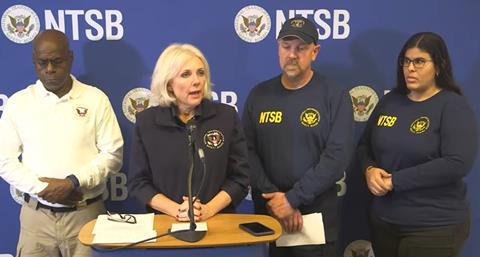The US National Transportation Safety Board (NTSB) said that damage to a door plug which blew out of an in-flight Alaska Airlines Boeing 737 Max 9 last week includes fractured guide fittings that hold the plug in place.
In her third media briefing in as many days, NTSB chair Jennifer Homendy said on 8 January that while information is still being gathered on the cause of the blow-out, experts have been able to identify which parts of the aircraft’s door plug failed, after the piece was found in a yard in Portland, Oregon and recovered.
“We cannot tell you at this time how and why,” she says. “We will have that information, it’s going to take time, we are going to have to analyse the components.”

According to NTSB aerospace engineer Clint Crookshank, there are 12 stop pads on the door frame in the fuselage, and 12 stop pins on the door plug. For the door to be secured in place, they must meet and push against each other.
“To install that plug in the fuselage, you rotate it up so that the plug stop is above the door stop, it translates inboard and down so that the stops engage,” he says. “Four stop bolts are installed in the mechanism. There is a guide roller on each side, on the upper side of the door frame, that engages with a guide fitting on the plug.”
“The examination shows that all 12 stops became disengaged allowing [the door plug] to blow out of the fuselage. Both guide roller tracks were fractured,” Crookshank adds.
“The door translated up, disengaged from the stops, and fractured the fittings.”
“We have not yet recovered the four bolts that restrain it from its vertical movement, and we have not determined if they existed there,” Crookshank adds.
Why all that happened shortly after the aircraft took off is still a mystery, though, the investigators say.

Homendy says that the team is still searching for parts that detached from the aircraft during the explosive decompression event. A bottom hinge fitting and a spring that belonged to the mechanism are still missing.
“It’s not key to the investigation, but its always nice to have all the pieces,” she says. During the day, a plastic window frame and a headrest were found by members of the community, and turned in to the NTSB.
The safety agency’s structures team on site in Portland examined the undamaged, right door plug on the airframe, and “found no discrepancies, everything was in place”, she adds.
The NTSB chair also on 8 January clarified two safety questions which had come to light on the first day of the investigation into the damage on the two-month old airframe: The cockpit door that had blown open during the depressurisation event, and repeated illumination of the “fail light” on the pressurization system in the weeks prior to the accident.
“The cockpit door is designed to open during rapid decompression but no one among the flight crew knew that; they were not informed,” she says.
“Boeing is going to make some changes to the [operations] manual, which will translate into procedures and information for the flight attendants and for the crew in the cockpit.”
FAIL LIGHT
The faulty fail light that had illuminated on three previous occasions – on 7 December, on 3 January and on 4 January - is part of a “triple redundant” system, and also performed as it was intended to.
“This system is designed as a triple-redundant system with one primary cabin pressure controller, a computer system. There is a secondary computer system and there is a manual controller,” Homendy says. “If the primary controller fails, the flight crew switches to the secondary controller. If that fails, they can switch to manual.”
According to the aircraft’s maintenance logs, the redundant system “operated as designed” during the three events, and did not need to go into manual mode.
“At this time, we have no indications whatsoever that this correlated to the expulsion of the door plug and the rapid decompression,” she adds.

After the accident on N704AL, which was operating as flight 1282 from Portland to Ontario, California on 5 January, the FAA grounded 171 examples of the jet, and is requiring inspections to ensure that the door plugs are installed and secured correctly.
Earlier in the day, reports emerged that Chicago-based United Airlines – the world’s biggest operator of the Max 9 with 79 examples in its fleet – and Alaska had come across some anomalies in the door plugs on their aircraft. United said that it found ”bolts that needed additional tightening” on several of its aircraft.
Homendy says she is aware of the reports, and intends to follow up with the carriers directly.
“We are not shy about going broader than just this aircraft,” she says. “We need to first and foremost figure out what happened here on this aircraft, and if we have a bigger system-wide or fleet issue we will issue an urgent safety recommendation to push for that change.”












































